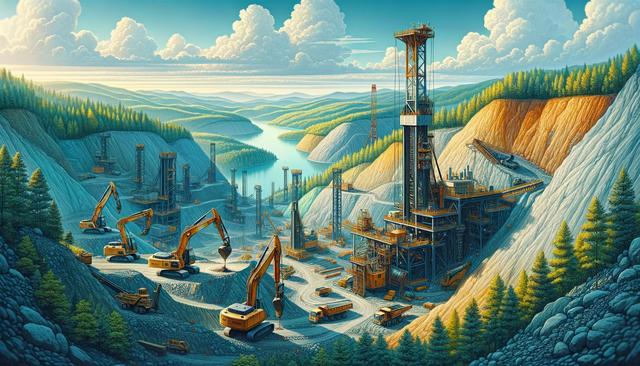The Role of Mining and Drilling Services in Resource Extraction
Mining and drilling services are critical components of the global supply chain for minerals, metals, and fossil fuels. These services include activities such as geological surveying, exploration drilling, core sampling, and the actual extraction of materials. The industry supports not only energy production but also the manufacturing of electronics, construction materials, and transportation infrastructure. Modern mining and drilling operations rely heavily on technological innovation to improve efficiency, reduce environmental impact, and ensure worker safety.
Key functions of mining and drilling service providers include:
- Site analysis and geological surveys
- Exploration and resource estimation
- Drilling for mineral or hydrocarbon extraction
- Environmental assessments and compliance reporting
- Mine development and operational support
By offering these specialized services, companies help streamline project timelines and reduce operational risks for mining firms and energy producers. As demand for critical minerals continues to rise, especially for use in renewable energy technologies and electric vehicles, mining and drilling services are more vital than ever.
Inside the World of Top Mining Companies
Leading mining companies across the globe rely on a network of specialized service providers to support their operations. These corporations manage extensive portfolios of mining projects, ranging from open-pit mines to deep underground operations. Mining and drilling service providers play an essential role in helping these companies assess resource potential, extract materials efficiently, and meet regulatory requirements.
Some characteristics that define the operational landscape of top mining companies include:
- Large-scale operations with global footprints
- Commitment to sustainability and environmental stewardship
- Use of advanced technologies such as automation and AI
- Focus on safety and workforce development
These companies often partner with drilling contractors and geotechnical experts during early-stage exploration and feasibility studies. Later, they rely on blasting services, drilling equipment suppliers, and engineering consultants to bring mines into production. The synergy between mining firms and service providers is instrumental in ensuring consistent output and long-term project viability.
Technological Advancements Shaping the Industry
The mining and drilling sector has undergone significant transformation in recent years due to the integration of digital technologies and automation. From autonomous drilling rigs to real-time data monitoring systems, innovations are redefining how resources are located, extracted, and processed. These advancements not only enhance productivity but also improve safety and environmental outcomes.
Some notable technological innovations include:
- Remote-controlled and autonomous drilling equipment
- 3D modeling and geospatial data analysis
- Real-time sensor-based monitoring systems
- Predictive maintenance using AI and machine learning
These tools allow service providers to offer more accurate data, reduce downtime, and minimize operational disruptions. Furthermore, they help companies remain competitive by lowering extraction costs and improving yield rates. As the industry continues to evolve, embracing new technologies will be key to sustaining growth and meeting global resource demands.
Environmental and Regulatory Considerations
Environmental stewardship and regulatory compliance are central to modern mining and drilling operations. Governments and international bodies have implemented stringent guidelines to ensure that resource extraction does not compromise ecosystems or public health. Service providers must navigate a complex web of environmental laws, safety standards, and community expectations to maintain operational licenses and social acceptance.
Key areas of focus include:
- Water management and pollution control
- Air quality and dust suppression
- Land rehabilitation and biodiversity conservation
- Engagement with local communities and indigenous groups
Mining and drilling companies often conduct environmental impact assessments (EIAs) and implement mitigation plans to address potential risks. Service providers contribute by offering expertise in environmental monitoring, waste management, and sustainable engineering solutions. By aligning with best practices and regulatory frameworks, the industry can reduce its ecological footprint and build trust with stakeholders.
Workforce Development and Safety Standards
Workforce development and safety are foundational pillars of the mining and drilling industry. Given the high-risk nature of operations, companies invest heavily in training programs, protective equipment, and safety protocols. A well-trained workforce not only improves operational efficiency but also minimizes the likelihood of accidents and injuries on site.
Core aspects of workforce development include:
- Technical training and certification for operators
- On-site safety drills and emergency response planning
- Health monitoring and wellness programs
- Diversity and inclusion initiatives
Service providers also play a role in ensuring that safety standards are upheld across various project phases. From exploration to decommissioning, they bring in specialized knowledge on hazard identification, risk assessments, and compliance audits. As automation becomes more prevalent, the demand for digitally skilled workers is increasing, prompting companies to incorporate advanced training modules into their workforce strategies.
Conclusion: Navigating the Future of Mining and Drilling Services
As the global demand for minerals and energy continues to grow, mining and drilling services will remain a cornerstone of industrial development. By embracing technological innovation, prioritizing environmental responsibility, and investing in workforce development, these services are well-positioned to support sustainable growth. For industry stakeholders, understanding the evolving landscape of mining and drilling is essential to making informed decisions and building resilient supply chains. Whether you’re a project manager, investor, or policy maker, staying informed about these services can offer valuable insights into the future of resource extraction.




Leave a Reply